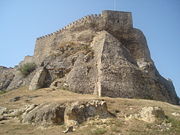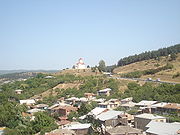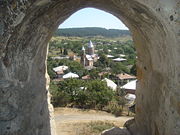
Surami
Encyclopedia
Surami is a townlet (daba) in Georgia
’s Shida Kartli
region with the population of 9,800 (2002 Georgia Census). It is a popular mountain climatic resort and a home to a medieval fortress.
(alternatively known as the Surami Range) which divides Georgia into its eastern and western parts, 4 km from the town Khashuri
, to which Surami is connected through a railway spur.

 The first human settlement on Surami’s territory dates back to the early Bronze Age
The first human settlement on Surami’s territory dates back to the early Bronze Age
. It is probably the Surium of Classical
authors, specifically Pliny the Elder
(AD 23-79), who place it in the eastern part of Colchis
, towards Iberia
.
Strategically located at the entrance into the Borjomi Gorge
and guarding the road from eastern to western Georgia, Surami became a heavily fortified town in the 12th century. From the 1170s to the latter part of the 14th century, the fortress of Surami was a hereditary fief of the dynasty of the eristavs ("governors") of Kartli
(central Georgia), who assumed the surname of Surameli (სურამელი; literally, "[lord] of Surami").
Subsequently, Surami declined but retained its lively trading post as well as the fortress which was reconstructed in the 16th and 17th centuries. By the mid-18th century, according to Prince Vakhushti
, Surami had 200 households of Georgians
, Armenians
and Jews
. In the 1740s, Surami was used by Prince Givi Amilakhvari
as his base against King Teimuraz II
and Persians. After the prince’s surrender in 1745, the fortress was demolished, but later restored and exploited by the Russo-Georgian troops in anti-Ottoman
operations during the Russo-Turkish War (1768–1774). After the Russian annexation of Georgia in 1801, Surami housed a military post and was later popularized as a mountain climatic resort. In 1926, it acquired the status of "urban-type settlement
" (Georgian: daba).
 Surami is adjacent to the Borjomi-Kharagauli National Park
Surami is adjacent to the Borjomi-Kharagauli National Park
, noted for its diverse landscapes and abundance of historical monuments. The town itself houses The Mother of God Church complex constructed in the 16th-17th century, the 17th-19th century St. George’s Church and the Kviratskhoveli Church built in 1998.
The exact date when the Surami Fortress was built remains obscure. Its earliest structures possibly date to the 12th century, but it has been reconstructed several times since then. A local legend associated with the fortress was brought into classical Georgian literature by the writer Daniel Chonkadze
(1830-1860) and further famed by the Armenia
n filmmaker Sergei Parajanov in his award-winning feature film The Legend of Suram Fortress
in 1984.
The Museum of Lesya Ukrainka is dedicated to the memory of the notable Ukrainian
woman poet Lesya Ukrainka
(1873-1913) who spent her last months in Surami. The Museum consists of the house where the poet died, a library and Ukrainka's monument authored by the Georgian sculptress Tamar Abakelia
(1952).
Georgia (country)
Georgia is a sovereign state in the Caucasus region of Eurasia. Located at the crossroads of Western Asia and Eastern Europe, it is bounded to the west by the Black Sea, to the north by Russia, to the southwest by Turkey, to the south by Armenia, and to the southeast by Azerbaijan. The capital of...
’s Shida Kartli
Shida Kartli
Shida Kartli is a region in Georgia. It consists of the following districts: Gori, Kaspi, Kareli, Java, Khashuri.The northern part of the region, namely Java, and northern territories of Kareli and Gori, is controlled by the authorities of the self-proclaimed republic of South Ossetia since...
region with the population of 9,800 (2002 Georgia Census). It is a popular mountain climatic resort and a home to a medieval fortress.
Location
Surami is located on the southern slopes of the Likhi RangeLikhi Range
Likhi Range or Surami Range is a mountain range in Georgia, a part of the Caucasus mountains. It connects the Greater Caucasus and Lesser Caucasus ranges....
(alternatively known as the Surami Range) which divides Georgia into its eastern and western parts, 4 km from the town Khashuri
Khashuri
Khashuri is a town in central Georgia. It is located on the Mtkvari River.Khashuri is first mentioned in the 1693 document. Modern Khashuri was founded in 1872 as a modest railway halt called "Mikhaylovo" after Grand Duke Michael Nikolaevich of Russia, Viceroy of the Caucasus. In 1917, it was...
, to which Surami is connected through a railway spur.
History


Bronze Age
The Bronze Age is a period characterized by the use of copper and its alloy bronze as the chief hard materials in the manufacture of some implements and weapons. Chronologically, it stands between the Stone Age and Iron Age...
. It is probably the Surium of Classical
Classical antiquity
Classical antiquity is a broad term for a long period of cultural history centered on the Mediterranean Sea, comprising the interlocking civilizations of ancient Greece and ancient Rome, collectively known as the Greco-Roman world...
authors, specifically Pliny the Elder
Pliny the Elder
Gaius Plinius Secundus , better known as Pliny the Elder, was a Roman author, naturalist, and natural philosopher, as well as naval and army commander of the early Roman Empire, and personal friend of the emperor Vespasian...
(AD 23-79), who place it in the eastern part of Colchis
Colchis
In ancient geography, Colchis or Kolkhis was an ancient Georgian state kingdom and region in Western Georgia, which played an important role in the ethnic and cultural formation of the Georgian nation.The Kingdom of Colchis contributed significantly to the development of medieval Georgian...
, towards Iberia
Caucasian Iberia
Iberia , also known as Iveria , was a name given by the ancient Greeks and Romans to the ancient Georgian kingdom of Kartli , corresponding roughly to the eastern and southern parts of the present day Georgia...
.
Strategically located at the entrance into the Borjomi Gorge
Borjomi Gorge
Borjomi Gorge is a picturuesque canyon of the Mtkvari River in central Georgia. The Gorge was formed as a result of the Mtkvari River cutting its path through the Lesser Caucasus Mountains where the Trialeti and Meskheti Ranges meet. A significant portion of the Borjomi Gorge is covered by mixed...
and guarding the road from eastern to western Georgia, Surami became a heavily fortified town in the 12th century. From the 1170s to the latter part of the 14th century, the fortress of Surami was a hereditary fief of the dynasty of the eristavs ("governors") of Kartli
Kartli
Kartli is a historical region in central-to-eastern Georgia traversed by the river Mtkvari , on which Georgia's capital, Tbilisi, is situated. Known to the Classical authors as Iberia, Kartli played a crucial role in ethnic and political consolidation of the Georgians in the Middle Ages...
(central Georgia), who assumed the surname of Surameli (სურამელი; literally, "[lord] of Surami").
Subsequently, Surami declined but retained its lively trading post as well as the fortress which was reconstructed in the 16th and 17th centuries. By the mid-18th century, according to Prince Vakhushti
Vakhushti
Vakhushti was a Georgian prince , geographer, historian and cartographer.- Life :A son of King Vakhtang VI of Kartli , he was born in Tbilisi, 1696...
, Surami had 200 households of Georgians
Georgians
The Georgians are an ethnic group that have originated in Georgia, where they constitute a majority of the population. Large Georgian communities are also present throughout Russia, European Union, United States, and South America....
, Armenians
Armenians
Armenian people or Armenians are a nation and ethnic group native to the Armenian Highland.The largest concentration is in Armenia having a nearly-homogeneous population with 97.9% or 3,145,354 being ethnic Armenian....
and Jews
Georgian Jews
The Georgian Jews are from the nation of Georgia, in the Caucasus...
. In the 1740s, Surami was used by Prince Givi Amilakhvari
Amilakhvari
The Amilkhvari was a noble house of Georgia which rose to prominence in the fifteenth century and held a large fiefdom in central Georgia until the Imperial Russian annexation of the country in 1801. They were hereditary marshals of Georgia from c. 1433, from which the family takes its name...
as his base against King Teimuraz II
Teimuraz II
Teimuraz II , of the Bagrationi dynasty, was a king of Kakheti, eastern Georgia, from 1732 to 1744, then of Kartli from 1744 until his death.- Life :...
and Persians. After the prince’s surrender in 1745, the fortress was demolished, but later restored and exploited by the Russo-Georgian troops in anti-Ottoman
Ottoman Empire
The Ottoman EmpireIt was usually referred to as the "Ottoman Empire", the "Turkish Empire", the "Ottoman Caliphate" or more commonly "Turkey" by its contemporaries...
operations during the Russo-Turkish War (1768–1774). After the Russian annexation of Georgia in 1801, Surami housed a military post and was later popularized as a mountain climatic resort. In 1926, it acquired the status of "urban-type settlement
Urban-type settlement
Urban-type settlement ; , selyshche mis'koho typu ) is an official designation for a type of locality used in some of the countries of the former Soviet Union...
" (Georgian: daba).
Monuments and attractions

Borjomi-Kharagauli National Park
The Borjomi-Kharagauli National Park is a protected area in central Georgia, situated in the Lesser Caucasus, southwest to the nation’s capital of Tbilisi....
, noted for its diverse landscapes and abundance of historical monuments. The town itself houses The Mother of God Church complex constructed in the 16th-17th century, the 17th-19th century St. George’s Church and the Kviratskhoveli Church built in 1998.
The exact date when the Surami Fortress was built remains obscure. Its earliest structures possibly date to the 12th century, but it has been reconstructed several times since then. A local legend associated with the fortress was brought into classical Georgian literature by the writer Daniel Chonkadze
Daniel Chonkadze
Daniel Chonkadze was a Georgian novelist primarily known for his resonant novella Suramis tsikhe ....
(1830-1860) and further famed by the Armenia
Armenia
Armenia , officially the Republic of Armenia , is a landlocked mountainous country in the Caucasus region of Eurasia...
n filmmaker Sergei Parajanov in his award-winning feature film The Legend of Suram Fortress
The Legend of Suram Fortress
The Legend of the Suram Fortress is a 1984 film directed by Georgian SSR-born Soviet-Armenian director Sergei Parajanov, his first film after 15 years of censorship in the Soviet Union, a film stylistically linked with his earlier The Color of Pomegranates : The film consists in a series of...
in 1984.
The Museum of Lesya Ukrainka is dedicated to the memory of the notable Ukrainian
Ukraine
Ukraine is a country in Eastern Europe. It has an area of 603,628 km², making it the second largest contiguous country on the European continent, after Russia...
woman poet Lesya Ukrainka
Lesya Ukrainka
Larysa Petrivna Kosach-Kvitka better known under her literary pseudonym Lesya Ukrainka , was one of Ukraine's best-known poets and writers and the foremost woman writer in Ukrainian literature. She also was a political, civil, and female activist....
(1873-1913) who spent her last months in Surami. The Museum consists of the house where the poet died, a library and Ukrainka's monument authored by the Georgian sculptress Tamar Abakelia
Tamar Abakelia
Tamar Abakelia was a Georgian sculptress, theater designer and illustrator. She was granted the title of Honored Artist of the Georgian SSR in 1942.- Family :...
(1952).

